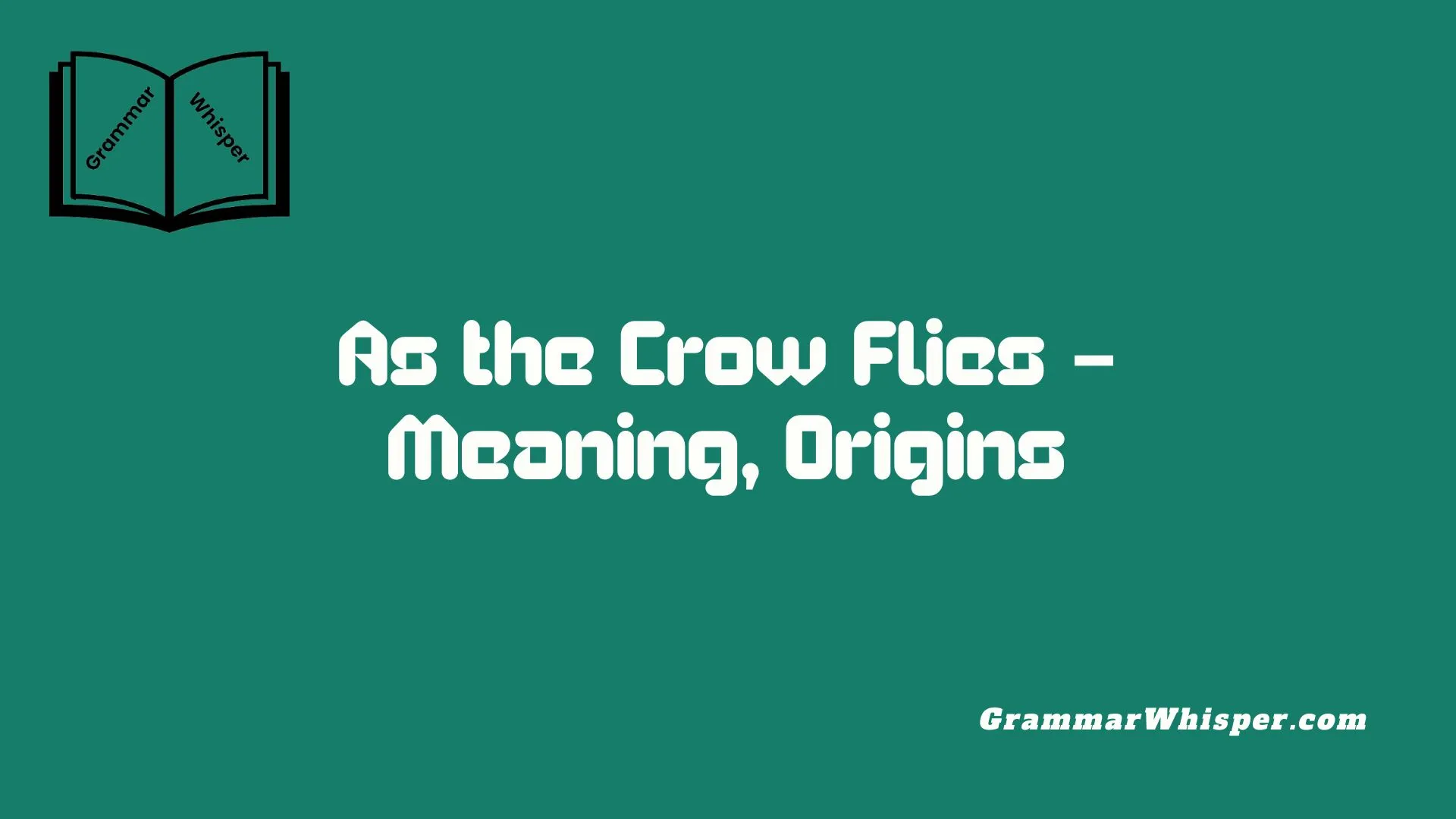In the world of language, certain expressions do more than decorate our conversations – they connect us to nature. The idiom “as the crow flies” is a perfect example. Whenever I’m planning a road trip or designing a map, I always consider how a straight line differs from a curved path. That small idea changes how we measure and describe distance, and it adds nuance and depth to everyday tasks. Whether you’re writing a novel, drafting a blog, or developing a metaphor, this idiom holds poetic charm and practical use. It simplifies directions and sharpens our understanding of what “straight” or direct really means in physical space.
The meaning and origin of this phrase trace back to the natural flight of crows, which are believed to move in straight lines between two points. Through my hands-on experience in navigation and technology projects, I’ve seen the phrase pop up in real-world applications – from mapping systems and GPS tools to conceptual writing. This article explores its practical usage, confronts popular misconceptions, and uncovers the fascinating story of how this idiom spread through modern literature, historical texts, and the tools we rely on today. The concept might seem simple, but it’s deeply woven into how we see and move through the world.
Understanding the Idiom ‘As the Crow Flies’
The idiom “as the crow flies” describes the shortest, most direct path between two points on Earth – a straight line, unaffected by roads, rivers, or other obstacles. It’s commonly used in navigation, geography, and informal speech to convey a sense of ideal distance.
“The village is 20 miles away as the crow flies, but it’s a 40-mile drive by road.”
This expression contrasts actual travel routes (which may involve turns, detours, and terrain challenges) with an imaginary straight-line path. That path rarely exists in practice, but it serves as a benchmark for proximity.
The Literal vs. Figurative Meaning
Although the idiom invokes crows and their flight, its meaning is largely figurative. The phrase does not imply that crows literally fly in perfectly straight lines – because they don’t. Instead, it paints a mental image of a direct aerial route, bypassing all surface-level obstructions.
Figuratively, it’s a metaphor for efficiency, simplicity, and uninterrupted distance. People also use it to highlight the disparity between two forms of measurement:
| Mode of Measurement | Distance (Example) | Notes |
| As the crow flies | 50 miles | Straight-line, shortest distance |
| By road (via highways) | 72 miles | Includes detours, curves, speed limits |
| By public transport | 90 miles | Includes route schedules, transfers |
Real Synonyms, Variants, and Regional Phrases
Different cultures express the idea of straight-line distance in various ways. While “as the crow flies” is widely used in English-speaking countries, there are other synonymous phrases and idiomatic counterparts:
English Variants:
- “In a straight line”
- “Point-to-point”
- “Bee-line route” (another animal-based idiom!)
Regional/International Variants:
- French: “à vol d’oiseau” (like a bird’s flight)
- German: “Luftlinie” (air line)
- Spanish: “en línea recta” (in a straight line)
These alternatives all reflect the same core idea: the most direct route between two places, often from an aerial or abstract perspective.
Origins of ‘As the Crow Flies’ – A Historical Overview
The first recorded use of the phrase appeared in the early 18th century. It gained popularity during a time when seafaring, exploration, and cartography were central to global affairs.
One of the earliest known references comes from William Lithgow, a Scottish traveler and author, in 1738:
“It is better accounted by land than as the crow flies.”
This suggests the phrase was already in colloquial use at the time. It emerged in parallel with increased reliance on compass-based navigation and map-making, where straight-line distances became crucial.
The Nautical Connection and the Crow’s Nest
There is a popular belief that the phrase stems from naval history, specifically from the use of a “crow’s nest” atop ship masts. Sailors allegedly kept caged crows or ravens on board. When lost or close to shore, they would release the birds to see which direction they flew – hoping the birds would head directly to land.
While this origin sounds romantic, there’s no concrete evidence to support the idea that releasing crows was standard maritime practice. However, the crow’s nest itself – a lookout post on tall masts – did serve as a symbol of perspective and range, metaphorically tying back to the idiom.
Crows in Nature vs. Crows in Language
In truth, crows don’t always fly straight. They’re intelligent birds that make deliberate, often complex flight paths, depending on obstacles, wind, and food sources. This undermines the literal image of a crow taking the shortest route.
Still, language isn’t science. The idiom is based not on ornithology but on symbolism and visual storytelling. Crows soar through open skies, unrestricted, which creates the illusion of straight, determined flight – perfect for metaphor.
Fun fact: Crows have remarkable problem-solving abilities and even recognize human faces, adding another layer to why they’re often used in metaphorical expressions.
Misconceptions and Folk Etymology
Despite its mainstream usage, the idiom has several incorrect origin stories:
- Crows as navigation tools on ships – Popular but unverified.
- Used by medieval hunters – Not documented in period texts.
- Ancient aviation techniques – Anachronistic.
The phrase likely evolved through oral tradition, shaped by poetic language and the natural imagery that crows offer. Over time, people added meanings and stories to make the idiom more memorable.
Geodesic Distances – The Mathematical Reality
From a scientific and geographic perspective, “as the crow flies” is most closely related to geodesic measurement – the shortest path between two points on the curved surface of a sphere (Earth).
With modern technology, we now calculate these direct distances using satellites, GPS, and mapping software:
| Tool/Platform | How It Uses “As the Crow Flies” |
| Google Maps | Offers direct line distance |
| GIS Software (ArcGIS, QGIS) | Generates geodesic paths |
| Logistics software | Used in fleet optimization |
| Military applications | Plots aerial operations |
Understanding the geodesic concept adds accuracy and clarity to how the idiom is interpreted in technical settings.
How the Idiom Is Used Today
Today, “as the crow flies” appears in:
- News headlines (“The storm is just 30 miles away as the crow flies”)
- Weather forecasts
- Travel blogs and vlogs
- Business logistics (especially in shipping and delivery sectors)
- Aviation and air traffic planning
It’s also frequently used metaphorically in fiction and nonfiction writing to describe emotional or metaphorical distance.
Examples in use:
“Her childhood home was only 5 miles away as the crow flies, but it felt like another world.”
“The factory is 15 miles as the crow flies, but traffic makes it a 90-minute drive.”
When Not to Use ‘As the Crow Flies’
Although poetic, this idiom can cause confusion in technical conversations or international settings where the expression isn’t commonly known.
Avoid using it when:
- Giving directions to tourists or non-native speakers
- Writing scientific reports requiring precise measurements
- Clarity is more important than style
Use these alternatives instead:
- “Straight-line distance”
- “Geodesic measurement”
- “Aerial distance”
Practical Examples and Visual Breakdown
Let’s compare three real-world cities:
| Route | Distance As The Crow Flies | Road Distance | Travel Time (By Car) |
| New York to Philadelphia | 81 miles | 95 miles | ~1.5 – 2 hours |
| London to Oxford | 52 miles | 62 miles | ~1.5 hours |
| Lahore to Islamabad | 168 miles | 233 miles | ~4 – 5 hours |
These numbers demonstrate how actual travel can differ significantly from aerial measurement, especially in areas with less direct infrastructure.
Visual tip: Use GPS or drone-view maps to plot straight-line routes and compare them with Google Maps driving routes.
Final Thoughts
“As the crow flies” is more than just a quirky saying. It’s a linguistic snapshot of how humans visualize simplicity, efficiency, and distance. Despite its imprecise origin, it endures in modern speech because of its visual clarity and poetic resonance.
By understanding the idiom deeply – its history, cultural interpretations, and practical limitations – you become a better communicator. Whether you’re writing a novel, plotting logistics, or simply giving directions, using the phrase consciously makes a difference.
FAQs
What does “as the crow flies” mean?
“As the crow flies” refers to the shortest distance between two points on a map, ignoring all roads, obstacles, or terrain. It’s a way of describing direct, linear distance rather than the route one would actually travel.
Is “as the crow flies” used in technical fields?
Yes, this idiom is commonly used in geography, aviation, navigation, and logistics to describe straight-line distance. In modern times, it’s often used in GPS systems and mapping applications to differentiate from road distance.
Where did the phrase “as the crow flies” originate?
The phrase dates back to at least the 18th century. Some historians believe it was linked to nautical navigation, where sailors in crow’s nests gauged direction and distance. Crows were thought to fly in straight lines back to land, aiding orientation at sea.
Do crows actually fly in a straight line?
Not always. While the idiom assumes they do, studies of crow flight patterns show they may adjust direction based on wind, terrain, and threats. The phrase remains symbolic, even if not scientifically perfect.
How can I calculate distance “as the crow flies”?
You can use tools like Google Maps, GPS distance calculators, or geodesic formulas to measure straight-line distances. These are especially helpful in urban planning, aviation, or when estimating delivery routes.











